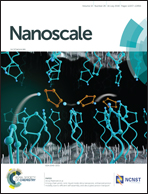Radiation damage during in situ electron microscopy of DNA-mediated nanoparticle assemblies in solution†
Abstract
Oligonucleotide–nanoparticle conjugates, also called programmable atom equivalents, carry promise as building blocks for self-assembled colloidal crystals, reconfigurable or stimuli responsive functional materials, as well as bio-inspired hierarchical architectures in wet environments. In situ studies of the DNA-mediated self-assembly of nanoparticles have so far been limited to reciprocal space techniques. Liquid-cell electron microscopy could enable imaging such systems with high resolution in their native environment but to realize this potential, radiation damage to the oligonucleotide linkages needs to be understood and conditions for damage-free electron microscopy identified. Here, we analyze in situ observations of DNA-linked two-dimensional nanoparticle arrays, along with control experiments for different oligonucleotide configurations, to identify the mechanisms of radiation damage for ordered superlattices of DNA–nanoparticle conjugates. In a biological context, the results point to new avenues for studying direct and indirect radiation effects for small ensembles of DNA in solution by tracking conjugated nanoparticles. By establishing low-dose conditions suitable for extended in situ imaging of programmable atom equivalents, our work paves the way for real-space observations of DNA-mediated self-assembly processes.



 Please wait while we load your content...
Please wait while we load your content...